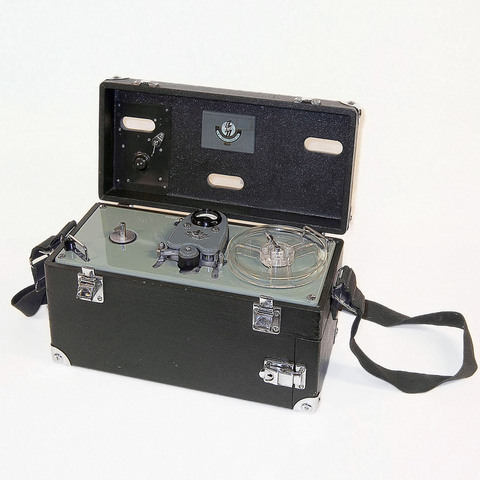Magnétophone à bande magnétique
Fiche détaillée
Type de l'appareil
enregistreur portable à bande magnétique ; boîtier gaîné de cuir ; réembobineuse au dos du couvercle ; électronique à lampe ; alimentation par piles 1.5V et batterie 67.5 V ;
Auteurs
Informations non disponibles
Fabricants
E.M.I.
Londres
Utilisateurs
Informations non disponibles
Distributeurs
Informations non disponibles
Sujet du modèle
Informations non disponibles
Objectif
Informations non disponibles
Taille de l'objet
Ouvert :
Informations non disponibles
Fermé :
Longueur : 17 cm
Largeur : 37 cm
Hauteur : 22 cm
Diamètre :
Informations non disponibles
Taille de la boîte de transport
Informations non disponibles
Remarques
Marque : "E.M.I. Sales & Service LTD Made in Gt. Britain".
"This is one of the first portable reel to reels that EMI produced, although there where others such as the TR-90 and some rare visions of the BTR-2, this was portable and not classed as Transportable. This machine is dated around 1957 and cost £102 18s, a frequency response of 50Hz - 7KHz and weighed in at over 14lb with the batteries in. The machines quickly earned themselves their name in the BBC and where very successful yet it appears not many survived. There were three different main models of this machine, the L2A running at 3.3/4 ips, the L2B (Most common) at 7.1/2 ips and the L2C running at 15ips, all of which I have but also I have one which has a pilot tone generator built in, this signal was recorded onto the tape so that the tape could be coupled up to a camera to make audio synchronisation easier. The unusual thing about this recorder are the heads, there are two as like many recorders however one is a record head and the other is a replay head, this means the tape used must be blank, rewinding the tape will cause a sound on sound effect if used a second time around. The recorder takes 8 X d-type battery cells, these are to power the motor, to power the valve amplifier inside, the recorder requires HT of 135 volts, to do this it requires two 67.5 volt batteries, so in total this little unit requires 10 batteries and over 144 volts total to run. these batteries have been paired up in this configuration so that the motor and HT batteries last about the same length of time, a total of 1.1/2 hours constant use. The battery life was actually increased to 1.1/2 hours by adding some power saving features, one is the rewind handle which is locate on the top of the lid, engaging it would allow the operator to be able to wind back the tape without using any battery life, the second was the lack of an erase head, with no erase head, there was no need to apply a drive circuit to it thus saving more power. Recently I was contacted by Howard Dell who worked in the tape machine development lab at EMI Electronics at the time that the TR51,TR52 and TR90 machines were being produced, and he comments that the L2 series were essentially BBC designs engineered for production by EMI. It was also the BBC who later converted the electronics from valves to transistors (RE321) which gave it a much longer battery life. This machine obviously dispensed with the HT battery but tape rewind was still with a crank handle!" (http://www.vintagerecorders.co.uk/VR_View_Page.asp?IDS=6).
